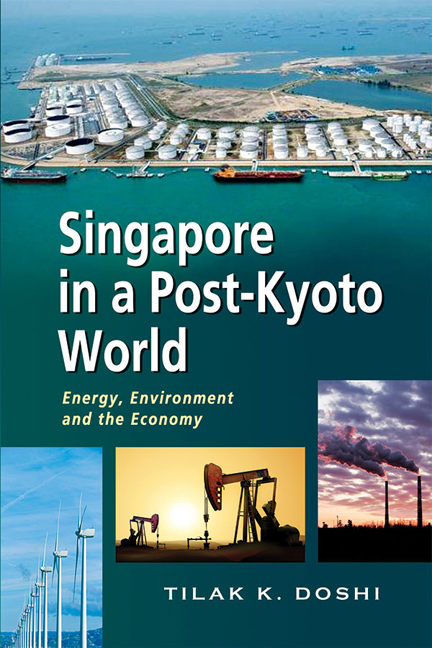Book contents
- Frontmatter
- Dedication
- Contents
- List of Tables and Figures
- Preface
- Acknowledgements
- List of Abbreviations
- Introduction
- 1 Economy, Energy, and Emissions
- 2 Climate Change Negotiations: From Copenhagen to Durban via Cancun
- 3 Climate Change Finance: Who Pays and Who Receives?
- 4 Singapore's External Sector: Impacts of Emission Mitigation Policies
- 5 Energy and Emissions: The Five Strategies
- 6 Concluding Remarks: “The Three E's”
- Index
- About the Author
4 - Singapore's External Sector: Impacts of Emission Mitigation Policies
Published online by Cambridge University Press: 19 May 2017
- Frontmatter
- Dedication
- Contents
- List of Tables and Figures
- Preface
- Acknowledgements
- List of Abbreviations
- Introduction
- 1 Economy, Energy, and Emissions
- 2 Climate Change Negotiations: From Copenhagen to Durban via Cancun
- 3 Climate Change Finance: Who Pays and Who Receives?
- 4 Singapore's External Sector: Impacts of Emission Mitigation Policies
- 5 Energy and Emissions: The Five Strategies
- 6 Concluding Remarks: “The Three E's”
- Index
- About the Author
Summary
The question as to whether “country competitiveness” is analogous to that of a firm's competitiveness is often assumed away, and policymakers in the United States, Europe, and Japan routinely talk of national competitiveness. Among economists, however, there is no consensus on how to measure, explain, and predict international competitiveness of countries, and “perhaps none is warranted”. In assessing the potential impacts of emission mitigation policies on countries, the term “competitiveness” is used here in reference to firms in key internationally competing industries such as shipping, aviation, and oil refining and trading rather than to any concept of an aggregate “national competitiveness index”.
Shipping, civil aviation, and oil refining and petrochemicals are three key areas of interest for Singapore, which are the subject of intense negotiations over emission reduction initiatives at the global industry or sector-specific levels. These are all industries of major significance to Singapore's role as Asia's leading transport and oil hub. Policies aimed at emissions reductions, be they local, regional, or global, will necessarily impact these key tradable goods sectors. Parallel to the post-Durban negotiations over larger strategic issues of national emission reduction targets, financing, and technology, the shipping and civil aviation industries will be subject to intense negotiations within the specialized bodies of the International Maritime Organization (IMO) and International Civil Aviation Organization (ICAO). Petroleum refining and petrochemicals, as one of the major energy-intensive, heavy industries competing in global commodity markets such as steel, cement, and primary metals, is also subject to strong “level playing field” advocacy for arriving at global sectoral agreements rather than as a subject of different national emission regulations.
SHIPPING
The port of Singapore has been amongst the top five busiest ports in the world for several decades. The American Association of Port Authorities in 2009 ranked Singapore as the world's busiest container seaport on the basis of the total number of actual “twenty-foot equivalent units” (TEUs) transported through the port and second, after Shanghai, in terms of total cargo volume. Singapore consistently ranks as one of the world's top competitive ports, in terms of tonnage and port efficiency. The Kyoto Protocol assigned responsibility for reducing bunker greenhouse gas (GHG) emissions to the IMO, an agency of the United Nations. The IMO has focused on technical discussion around standards such as fuel efficiency, fuel quality, slow steaming, etc.
- Type
- Chapter
- Information
- Singapore in a Post-Kyoto WorldEnergy, Environment and the Economy, pp. 119 - 167Publisher: ISEAS–Yusof Ishak InstitutePrint publication year: 2015

